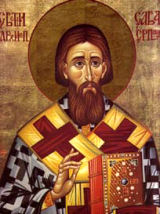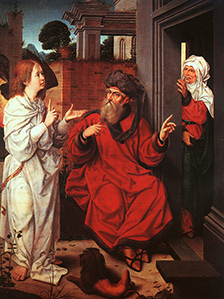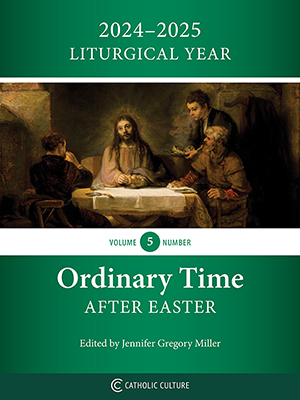Advent: December 5th
Friday of the First Week of Advent
Other Commemorations: St. Sabbas, Abbot (RM)
» Enjoy our Liturgical Seasons series of e-books!
In the General Roman Calendar, this date is a weekday in Advent. No feast of a saint is celebrated. Before the reform of the Roman Calendar in 1969, this was the memorial of St. Sabbas, abbot, a famous solitary of the 5th century, who ranks with St. Euthymus and St. Gerasimus as one of the chief organisers and luminaries of monasticism in Palestine, and whose rule had a great influence on Eastern donachism. His feastday is no longer on the General Roman Calendar, but has been transferred to particular calendars. Local churches, monasteries, and dioceses who claim St. Sabbas as their patron may still celebrate this saint's feast, and priests may celebrate his feast as an optional memorial.
![]()
Salvation History Meditation — Isaac
Today we reflect on Isaac who was a great type, or symbol of Christ. Both carried the wood on which they were to be sacrificed up a mountain. Isaac was the only son of Abraham; Christ was the only begotten son of God. The altar with the slain lamb prefigures the Sacrifice of Christ, the Lamb of God, on the Cross and the Holy Sacrifice of the Mass.
Symbols: bundle of wood; ram.
Suggested Readings: Genesis 22:1-2, 6-13, 15-19.
St. Sabbas
 Saint Sabbas the Sanctified was born in the fifth century in Cappadocia, in the pious Christian family of John and Sophia. His father was a military commander. Journeying to Alexandria on military matters, his wife went with him, but they left their five-year-old son in the care of an uncle. When the boy reached eight years of age, he entered the monastery of St. Flavian, located nearby. The gifted child quickly learned to read and became an expert on the Holy Scriptures. In vain did his parents urge St. Sabbas to return to the world and enter into marriage. At seventeen years of age he received monastic tonsure, and attained such perfection in fasting and prayer that he was given the gift of wonderworking. After spending ten years at the monastery of St. Flavian, he went to other monasteries. St. Sabbas lived in obedience at this monastery until the age of thirty.
Saint Sabbas the Sanctified was born in the fifth century in Cappadocia, in the pious Christian family of John and Sophia. His father was a military commander. Journeying to Alexandria on military matters, his wife went with him, but they left their five-year-old son in the care of an uncle. When the boy reached eight years of age, he entered the monastery of St. Flavian, located nearby. The gifted child quickly learned to read and became an expert on the Holy Scriptures. In vain did his parents urge St. Sabbas to return to the world and enter into marriage. At seventeen years of age he received monastic tonsure, and attained such perfection in fasting and prayer that he was given the gift of wonderworking. After spending ten years at the monastery of St. Flavian, he went to other monasteries. St. Sabbas lived in obedience at this monastery until the age of thirty.
He was later blessed to seclude himself in a cave. On Saturdays, however, he left his hermitage and came to the monastery, where he participated in divine services and ate with the brethren. After a certain time St. Sabbas received permission not to leave his hermitage at all, and he struggled in the cave for five years. After several years, disciples began to gather around St. Sabbas, seeking the monastic life. As the number of monks increased, a lavra sprang up. When a pillar of fire appeared before St. Sabbas as he was walking, he found a spacious cave in the form of a church.
St. Sabbas founded several more monasteries. Many miracles took place through the prayers of St. Sabbas: at the Lavra a spring of water welled up, during a time of drought there was abundant rain, and there were also healings of the sick and the demoniacs. The saint surrendered his soul to God in the year 532.
Symbols and Representation: Abbot with an apple; man holding the rule of his monastery in his hand; man seated at the edge of a cliff; man praying in a cave with a lion nearby
Highlights and Things to Do:
- Learn about the icon of the Mother of God called the "Milk-Giver" and its connection to St. Sabbas.
- Make preparations for the feast of St. Nicholas. Tonight many families put out their shoes or stockings for St. Nicholas to fill. Also many families celebrate with a party on St. Nicholas Eve.
- Don't forget to pray "Hail and Blessed be the hour...", the Christmas Anticipatory Prayer every day until Christmas.
- Read more about St. Sabas:
- Visit See the Holy Land to learn more about the ancient monastery established in the 5th century by St. Sabas.






